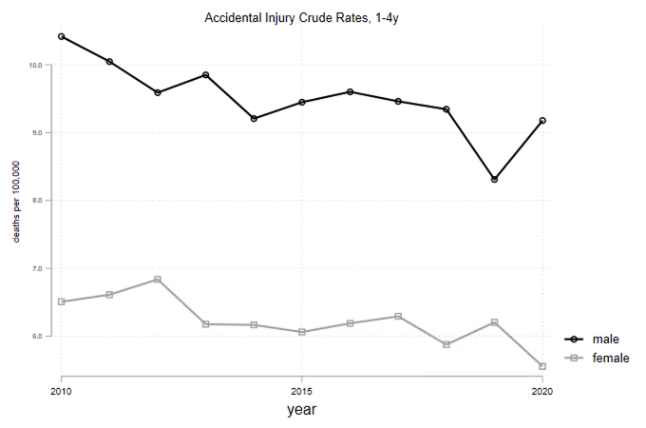
Advancing understanding of the demography of child well-being.
Measuring the Gender Gap in Infant and Child Unintentional Injury Mortality
Demographers have noted a male mortality penalty across the lifespan. However, the last detailed account of the early childhood “sex mortality ratio” was published 40 years ago. This project asks: Has the gender gap in early childhood mortality changed over the last 20 years? Using restricted detailed mortality and compressed vital statistics data from the U.S. over the period 2000-2020, we find that the gender gap in early childhood mortality has not significantly changed. We also show that accounts of the innate biological “fragility” of boys have been overemphasized. While boys do have higher rates of leading natural causes of death in infancy, contrary to existing theory they also have similar rates to girls between the 1-4 years of age. We find that boys have higher risk of mortality among causes where adult supervision is a key contributing factor, such as drowning, poisoning, falls, or firearms. From these findings, we argue that that current accounts of the gender gap in early childhood mortality are insufficient and that social causes have been ignored. We then theorize that gendered supervision is a cause of the gap in accidental injury deaths, which is the leading cause of death for those aged 1-4 and the fifth leading cause for those aged 0-1.
Blumenthal, A. & Martin, K.A. (Revise & Resubmit). Boys at risk beyond male fragility: The gender gap in child injury deaths in the United States. Demography.
Furthering the Demography of Children’s Time Use
How and where a child spends their time directly impacts the nature of their developmental context as well as potential exposure to risk and protective factors that shape developmental outcomes. Studies of children’s time use have been influential in informing our understanding of the risk and protective factors that guide developmental processes. The Child Development Supplement (CDS) to the Panel Study of Income Dynamics (PSID) uses a time diary with codes attached for primary and secondary activity type, as well as details on who else was present during the activity to measure children’s time use. Because these data are rich and complex, few studies have tackled questions on activity place or supervision of young children, along with activity type. An ongoing project I have examines patterns of children’s time use by both activity type and activity place in the U.S. from 2014-2020. We also examine time use patterns by age, socio-economic resource (SER) level, and gender. To address the issue of activity place, we created a novel coding system that allows for the construction of population-level estimates of children’s outdoor time use for the very first time.
Blumenthal, A., Dotterer, H. L., & Gard, A. M. (2022). Where are the kids? Contemporary patterns in U.S. children’s time use by age, gender, and socioeconomic resources. Stage 1 Registered Report. Infant and Child Development.
Child Asset Poverty Measurement
Wealth is a durable economic resource and it is typically held by individuals over the long-term. Measuring the wealth-type resources held by families, lends important information about the financial security of children. Following others, we argue that wealth provides additional information regarding child well-being, complementing traditional income-based measurements. In this paper, we extend the traditional income measure of child poverty in Canada to include wealth, by defining and presenting two measures of low-assets, or asset poverty. We present a novel estimation of child asset poverty in Canada and the first known estimation of child-level asset poverty more broadly. Focusing specifically on the measurement of asset poverty among children, we find that rates of asset poverty are two to three times as large as rates of income poverty. Prior literature highlights that higher asset levels are strongly associated with better outcomes for children, and families. The high levels of asset poverty in Canada, relative to other comparable nations, has implications for indicators of child well-being and the welfare of Canadian children.
Blumenthal, A. & Rothwell, D. W. (2018). The measurement and description of child income and asset poverty in Canada. Child Indicators Research, 6(11), 1907-1933.